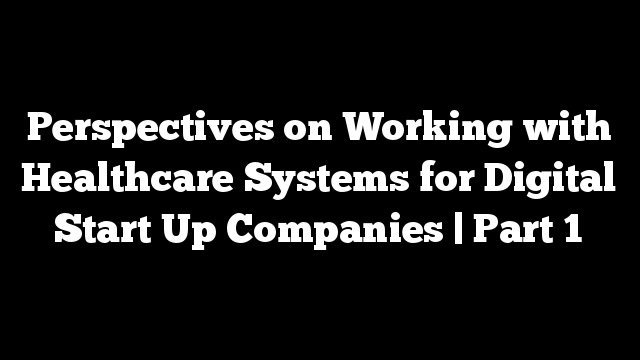

By SHAHID SHAH, MSc and BRIAN VAN WINKLE, MBA
Start-ups are an increasingly important “node” within the
healthcare ecosystem. They are challenging status quo concepts that have
long been ingrained in the healthcare system, like questioning the value of
traditional EMR systems, or shifting the power of information to patients, or
breaking down cost and quality transparency barriers. They may be the future of
the industry, but startups have a long way to go to truly transform the
system. The reasons are many, from an incredibly convoluted and bureaucratic
review process and rigid risk-controlling regulations and policies, to the
large-scale organizational inertia most of our healthcare systems have.
And while all of these hurdles can and will be overcome if we work
together, there are still several lessons each “node” in the ecosystem can learn to more effectively work with each other.
This article is directed at the emerging digital solutions trying
resiliently to help transform this stubborn industry. It provides some critical
lessons in dealing with healthcare systems and is accompanied by reactions from
a digital solutions expert with serial digital health entrepreneurship
experience. We hope to provide perspective from two people living and
breathing, and surviving, from both sides of the
equation every day.
Perspectives
and Reactions from the Industry
Healthcare Startups Must Understand how Provider
Systems Operate: Most
health systems are increasingly becoming rightfully skeptical about new
solutions because they feel the solutions don’t understand the environment of
their system. To help overcome the challenges of introducing your innovation into a complex business and
clinical environment, startups must understand how health systems operate to
include how they make decisions, contract and evaluate solutions.
Advice
(1)
Recognize that Decisions are Consensus-driven and Permissions-based: Unlike
other industries, where “shadow IT” is rampant and there can be one or two “key
decision makers,” in health systems you’re not likely to get very far without
figuring out how to build consensus among an array of influencers and then
figuring out how to get permissions from a group of key decision makers. You
should seek a “Sherpa” that understands enough about your solution to champion
the idea of change – which is really what you’re seeking when you’re
selling a new solution (the solution is just the means to accomplish the change,
it’s the change that’s hard). The first thing to focus on is to identify the
group of decision makers and how you convince them that the status quo should
be abandoned in favor of any change –
then, once you know how to convince them of some
change you’ll work with the group to get the right permissions to work on the
change management process – which will then influence a purchase of your
solution.
(2) Walk
a Mile in the Systems’ Shoes: If you’re getting into
the healthcare industry and most of your cofounders or senior leaders have
never worked inside a healthcare
system, then do volunteer work at a potential client to truly understand their needs. Find the department(s) that may be
buyers of your system and figure out a way to work in that department to
understand all the nuances of their current (“as
is”) and future (‘to be”, with your solution) workflows. Once you’ve walked a
mile in the systems’ shoes, your solution will be much better, and you’ll find
it easier to build consensus and get the right permissions from multiple
stakeholders across multiple departments.
(3)
Understand the Budgeting, Procurement and Buying Process:
Health systems are often similar to governments in that they have multi-year
budgeting cycles, complex procurement processes, and stringent buying
conditions. Even if you find the right group to build consensus around, and you
can even get permission to buy your product, your solution may not have been
budgeted for the current procurement cycle. Before you get too far in your
sales cycle, check to ensure that budget is available, procurement is possible,
and that the terms of a purchase are something you can live with.
Know the
Difference Between Fixed and Variable Costs: Your claim to reduce cost
dramatically often misses the differences between fixed costs and variable
costs. It’s true in the long run that disrupting the cost equation may include fixed costs
(reducing the big hospital footprint or repurposing) but in the short term,
these hospitals are stuck with the real estate and capital equipment that keeps
fixed costs high despite decreasing readmissions. Claiming to reduce
readmissions to the emergency department, for example, is an admirable and much
needed goal. But claiming the reduction will decrease the operating costs
associated with running that department is just misleading.
Advice
Work with
the Healthcare System to Build a Business Case that Makes Sense for Them: Before
you start giving out-of-context cost reduction figures, offer to work with the
health system to understand their current “as is” process that you’re trying to
improve. If the provider organization doesn’t even have
the staff to work with you to understand the current costs, they either don’t
care enough or won’t have enough capability to work with you and your solution.
To overcome the hurdles, help define some simple business metrics, using the
novel Objectives and Key Results (“OKR”) framework and then put in some basic
metrics data capture capabilities in place that will let you help explain to
the health system what their actual costs are. Once you and they know their
actual costs, then you can start to model what the potential savings might be.
It’s not
just about the clinical outcomes, but the financial and administrative ones: Showing clinical results or
outcomes from studies is a step in the right direction, but unless there are
complimentary financial (increased revenues or decreased costs) and
administrative results (less paperwork or decrease in phone calls), providing clinical
evidence isn’t enough. What good, for example, is it to know a digital
solution can reduce medication errors when we don’t know the financial cost of
those specific errors to our healthcare systems.
Results
have to be easily localized as well. It’s true on-time OR
starts costs the industry millions, but to really resonate, you’ll need data
from our healthcare systems, which can then be converted to opportunity costs
that will be sure to get our attention.
Advice
Co-Create
Balanced OKRs with Decision Makers: Create appropriate OKRs
for each outcome you’re targeting and see if the department heads or senior
leaders buy into those OKRs. Extend the data capture and discovery phase to
properly document and compare OKRs across different shifts. If you cannot get
buy in on the proper OKRs and how the KRs should be improved, you’ll never get
a health system to actually purchase your solution either.
Free is a Trojan Horse: Your free pilot is a Trojan
horse, distorting the economics of scaling your product. And the people you are
selling to, those with the greatest pain are often those without a budget, or
ability to weigh options. You are then competing for a client that is price
agnostic and competition blind. It is hurting both of us. Testing, studies, or
pilots should have costs associated with them, either real or just accounted for. And for those “free pilots”, clear
end points with specific goals in mind should be pre-set to help kick-start
next steps.
Advice:
Partner to do As IS Business Modeling and Have Clear Decision
Points: Instead of offering your service or
solution for free or running a pilot, offer to do the “as is” business
modeling, OKR development, and metrics capture for free. Then, as a
deliverable, offer a report that could model and describe what your solution
would be able to do to adjust the OKRs up or down (based on what’s most important to the health
system). Once you have real financial and clinical metrics, you know your OKRs,
and you get consensus on what your solution would offer in terms of a return on
the innovation then you’re ready for a real pilot that could be paid for by the
hospital because they know what they’re getting.
It’s not easy getting innovative products into health systems, but we hope you’ve seen in Part 1 of this post that there a few useful tips to get you well along your way. In Part 2, we’ll cover important questions like whether or not having a clinician on the team is crucial and how to cover objections.
Brian Van Winkle, MBA works with clinicians and health systems to tackle status quo thinking. He focuses on bringing the most innovative solutions and digital technologies to our hospitals to re-imagine how we provide and consume health.
Shahid Shah, M.Sc. is an award-winning Government 2.0, Health IT, Bio IT & digital Medical Device Inventor & CTO with over 28 years of technology strategy, architecture, engineering, entrepreneurship, speaking, and writing experience.
